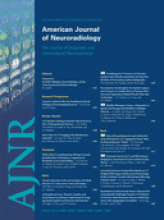Abstract
BACKGROUND AND PURPOSE: A substantial percentage of coiled aneurysms are associated with persistent filling of an aneurysmal component due to incomplete initial treatment or re-growth. Traditionally follow-up of coiled aneurysms has consisted of repeated intra-arterial cerebral catheter angiography, an invasive procedure with associated risks. Hence, many authors have advocated the use of non-invasive imaging techniques for this purpose. Our aim was to compare contrast-enhanced MR angiography (CE-MRA) with digital subtraction angiography (DSA) for depiction of aneurysmal remnants of coiled cerebral aneurysms.
MATERIALS AND METHODS: Aneurysms coiled between September 2003 and October 2006 were retrospectively reviewed. We included patients meeting the following criteria: 1) residual/recurrent aneurysm measuring 2 mm or greater, and 2) CE-MRA and DSA performed no more than 60 days apart. Three readers were asked to determine which technique was superior for characterization of the aneurysmal remnant: CE-MRA, DSA, or indeterminate. Statistical analysis included most rule and κ statistics.
RESULTS: Of 232 patients who underwent coiling, 44 met the inclusion criteria (33 women and 11 men; 24–72 years of age). Sixteen patients had neck remnants and 28 had body remnants. The first study to identify the remnant was DSA in 35 patients and CE-MRA in 9. In 32 patients (32/44, 73%), the readers indicated that CE-MRA was superior to DSA for remnant characterization. CE-MRA and DSA were thought to be equivalent in 7 (16%), and DSA was preferred in 3 (7%). Two cases (5%) yielded ambiguous results. Of the 28 body remnants, 22 (78.6%) were characterized by remnant protrusion into the coil mass: In 20 of these (91%), the readers preferred CE-MRA over DSA, and in 2 cases (9%), the techniques were thought to be equivalent.
CONCLUSION: In patients with known aneurysm remnants, CE-MRA is at least equivalent to DSA for characterization of aneurysmal remnants after coiling. Contrast filling within the coil mass was more clearly seen with CE-MRA than with DSA.
- Copyright © American Society of Neuroradiology












